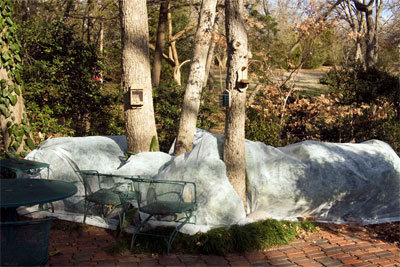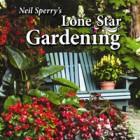Coping with Cold

Pay attention to 10-day forecasts during winter. If extremely cold weather is forecast several days out, check more frequently to see if the trends and expectations worsen.
Gardeners Steps to Plant Survival! Several extraordinary precautions may need to be taken for a bitter cold spell. Let’s look at each of them individually. Before we do, however, let’s define a few terms.
"Hardened" refers to a gradual preconditioning of plants and animals to increasingly worse (in this case, colder) weather. If your area has had several cold spells already, and if plants have become acclimated to the cold, that’s a good thing. They have become "hardened."
"Hardy" refers to the minimum temperature at which a properly hardened plant can be expected to survive. The USDA breaks the country into Hardiness Zones, and Texas falls into Zones 6-10. Click here to see the full USDA map. You need to know your area’s Zone ranking. Plants that are in a warmer Zone (larger number) will need heroic protection in this cold.
Moisture levels of the soil prior to, and during, hard freezes do a lot toward determining the extent of damage that may be done. Dry plants usually suffer far more damage. If your plants are dry, you should water them before the cold hits.
Covers, especially frost cloth ("floating row cover") can be used to hold solar warmth in the soil and around your plants. These coverings also help stop the harsh winter winds. They often do as much damage as the cold they accompany. Secure the frost cloth using bricks, river rock or other heavy anchors. If you don’t have frost cloth, use old sheets, blankets or burlap. Plastic is a poor covering material. It traps the sun’s heat the morning after a hard freeze, and plants thaw out far too rapidly. Damage below plastic covers is usually far worse than with even uncovered plants.
Tip for the future: Have a large roll of frost cloth on hand, even precut to fit over your plants, so that you can quickly put it into position when conditions dictate. Label the bags to make your work still easier.
Tip for the rest of this winter: If you have woody plants that appear to have been damaged by the cold, react slowly. Sometimes, only leaf tissues are damaged, and the plants come back very well as spring returns. Other times, stem tissues will be damaged, perhaps even to the ground. Pruning may be needed, but you should wait until March to assess the magnitude of any damage. Your only reliable clue before then will be if stem and twig tissues blacken, shrivel and turn brittle. In those cases, you can trim away that winter-killed wood. Otherwise, wait until early spring to determine your next steps.
Special Protection Tips
Here are your plant-by-plant guidelines.
Winter annual color. Pansies are the most winter-hardy annual plants, usually into single digits. Pinks and snapdragrons are next most durable, followed by ornamental cabbage and kale. If temperatures in your area are expected to fall into the teens, all will do better if protected with frost cloth. South Texas gardeners should protect petunias, stocks, poppies, alyssum and cyclamen if temperatures are expected to fall into the 20s.
Container plants. In general, you give up about two Hardiness Zones when you grow plants in containers. In other words, it’s like growing those same plants in an environment that is 20 degrees colder. Most landscaping shrubs become vulnerable when they’re still in pots when it turns really cold, which is why nurserymen overwinter them in gently heated (38 degrees F) greenhouses. If you have winter color container plants, or if you have shrubs and other woody plants in pots, either move them into a very protected location, or wrap their soil balls with insulation. Be sure they’re properly watered, of course.
Tender perennial species (including, depending on where you are in Texas, bananas, Mexican bush salvia, Mexican heather, elephant ears and many others). Every part of Texas has one or more types of perennials that are marginal in their winter hardiness for that region. Mulch over their beds to improve their chances of making it through the cold. Shredded tree leaves, compost, pine straw or pine bark mulch can all work, as will frost cloth.
Brand new groundcover plantings. If you have just planted Asian jasmine, star jasmine, ardisia or other type of groundcover that can sustain freeze injury in at least certain parts of the state, improve the plants’ odds of survival with a little extra care. If they’re dry, water them ahead of the freeze. Cover them with shredded tree leaves, compost or frost cloth until the severe cold has passed. Once established, these plants may be reliable in your area, but young plants won’t have the same extensive root systems.
At-risk woody shrubs. Again, this list will depend on where you live, but for much of Texas, it would include oleanders, loquats, pittosporums, certain palms, waxleaf ligustrums, gardenias and fatsias. If you are able to cover these plants with frost cloth, you will greatly improve their odds of surviving without severe leaf burn or even total loss of the plants. Secure the cover to the ground, so that warmth from the soil can be released and trapped beneath the cloth.
Living Christmas trees. Anytime you take a plant from a 70-degree room and plunge it into sub-freezing weather, you greatly increase the chance that it will freeze, even if it’s normally completely winter-hardy to your area. The plant is no longer hardened. If it’s already in the ground, cover it to protect it. If it’s still in a pot, set it in the garage for a day or two.
Standard plant species for your area. If you have chosen plants that are listed as hardy to your Zone, or to one that is colder (smaller Zone number), you should be fine. Again, water prior to the cold if the plants are dry.
Greenhouses. Your goal during extreme cold is just to keep things at or above 40 degrees F. If you’re using electric heat, or if you have a gas heater with a blower fan, have a back-up heat source in case power goes out. If you’re moving plants into the greenhouse, remember that most tropical plants will only tolerate 30-60 seconds of exposure to sub-freezing weather before they may be lost entirely.
Sprinkler system. Turn it to the "Off" or "Manual" positions so that it cannot run during sub-freezing weather. Modern "smart" controllers have these winter weather features built in. Many cities have initiated fines for sprinkler systems that cause traffic hazards, and the cost of the fine often approaches the cost of a new controller. These improved controllers make good sense at other times, too.
Valves and faucets. The safest thing to do is to disconnect all hoses from faucets. When hoses are left attached to older types of faucets during freezing weather, the water freezes within the faucets and often ruptures the pipes inside the walls of the house. It’s not a pleasant, nor an inexpensive repair. Be sure in-ground valve boxes are closed. Hopefully, your pressurized pipes will be deep enough to miss the freezing temperatures.
Garden hoses and hose-end sprinklers. Water expands as it freezes, and in so doing, it can rupture plastic and soft metal sprinkler parts. Hoses become brittle and must not be moved until all of the ice has melted again.
Garden supplies and pest control products. Dry products will not be at risk, so long as you keep them dry. Liquids, however, should not be allowed to freeze. Do not leave them in unheated storage facilities.
Garden ponds, including fish. (Information from Dickson Brothers in Mesquite, the water garden, pool and pond supply experts.)
• Small water features such as ceramic pots and fountains should be drained and dried.
• In-ground ponds without wildlife: pull equipment, drain and store dry until warmer weather.
• In-ground ponds with wildlife/fish: be sure the filter is working, and leave pond equipment running. You are relying on water movement to prevent freezing. Do not feed koi when water temperatures are below 55 degrees F.
• Swimming pools: freeze-guard equipment should keep things running below freezing. If you do not have that type of protection, turn the equipment on and leave it running during the cold spell.
A Few Added Items
Finally, other things we just need to do because we’re humans, and because we share this planet:
• Put water out for birds and wild animals. Fill your bird feeders using a type of seed that they really like. Black, oil-type sunflower seeds are most universally loved.
• Bring your pets indoors when it’s going to be too cold for dogs and cats to be outside in much of the state. If you’re heating the garage gently for them, be sure to protect against the danger of fire. Keep all things away from space heaters, and check wiring on electrical heaters. Be sure there is adequate ventilation if you’re using a gas space heater that does not have a carbon monoxide shut-off monitor.
• If you have outside walls to your house that have water lines, open the cabinet doors inside those walls. That usually prevents the pipes from freezing.

